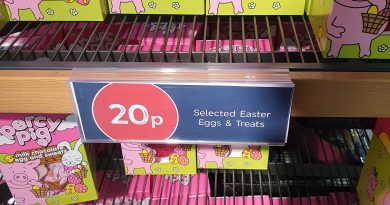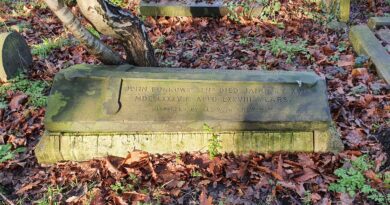Norwich – Rosary Cemetery (James Arthur Lake)
This is the grave of James Arthur Lake, located in Norwich’s Rosary Cemetery. James was baptised on 1 October 1861 in Poringland and he was the son of Nevil, a labourer, and Ellen, who had also had their daughter Louisa baptised the week before.
The 21-year old James married Eliza Gray, aged 20, at St. Mark’s Church in Lakenham on 27 November 1882. Eliza was the daughter of the shoemaker Thomas Gray, and they lived at Queens Road in the city. At the 1891 census, James and Eliza lived at 18 Cherry Street in Lakenham and they also had a four year old daughter.
Tragedy then hit the couple, and this is also mentioned on the gravestone itself, when there here was a train crash on 24 December 1891. It was reported in the local press on 28 December 1891 that three men had been killed, Walter Forster Mallett (aged 21, an engine fitter from Lowestoft), Harry John Reed (aged 26, a fireman from Lowestoft) and James Arthur Lake (aged 28, a guard from Norwich). There were over thirty other people injured and the inquest was adjourned until early January 1892.
The preliminary inquest at Lowestoft Police Court in January 1892 was well attended, and Eliza went along to hear the enquiry. Representatives from the Great Eastern railway company were also present and their representative, Mr. Moore, expressed their deep regret at the incident and offered their full co-operation. The coroner explained why he had arranged for the three bodies to be taken to Lowestoft, as although he said it was unusual to move the bodies five miles or so from the incident, he felt it had been the most appropriate course of action.
The members of the inquest jury were taken to the town’s mortuary, which was described by the coroner as “a disgrace to the Lowestoft”, before noting that it was “a happy fact” that the Great Eastern railway company were having it demolished for the expansion of the Trawl Basin. I’m not entirely sure that the relatives of the dead were heartened by this fact. The jury then went to look at the bodies and it was reported that “the corpses of the guard and the firemen were very repulsive, the nature of the injuries which each had sustained being such as to render their features well nigh unrecognisable”. The Victorian press certainly liked some graphic descriptions…..
There was a little confusion over the bodies and the coroner made some efforts to ensure that the bodies were identified correctly, although there was a delay when one witness refused to swear the oath. George A Howes, of 70, The Wilderness in Norwich swore that the body in the mortuary was James Arthur Lake. It was noted that James’s widow was in the court, but I assume that she didn’t look at the body.
There were a few more meetings of the coroner’s court to look into what happened, although the Great Eastern railway company admitted liability immediately and so there was no need to pursue this element. The Board of Trade then issued their summary of proceedings in March 1892, in a bid to ensure that there was no repeat of the catastrophe.
The report found that “the very serious collision was primarily caused by the driver of the up train, Alexander Boag, having completely miscalculated his position when approaching Barnby passing loop, where he was perfectly aware he had to stop”. Boag said that he overran the location that the Carlton Colville bridgeman should get on the train and then confused the bridgeman’s light for a signal to go. Boag then proceeded to Carlton Colville railway station (this is today known as Oulton Broad South station) without the bridgeman, “though there is an absolute rule to the contrary”. The thick fog meant that visibility was near zero and Boag said that there should have been fog signalmen in place to assist the train driver.
William Borrytt, the driver of the train going in the other direction, was seriously injured and had to give his evidence from bed at his home. He said that he had no time to apply his brake when he saw the train coming in the other direction, and the two engines collided. They didn’t hit each other full on due to the positioning of the engines, but it was clear immediately how bad an accident this was. It was mentioned with regards to James Arthur Lake that “the guard, who was in the third class brake carriage next the engine, which carriage was nearly destroyed, was killed on the spot, the deceased passenger being in the same carriage.”
The report concluded saying that it was the 26-year old Boag whose actions were the primary reason for the accident, but it noted that he was sober on the journey and was experienced with the route. Although he had only been a train driver for nine months, he had worked for the company for twelve years and had been a fireman for seven years. It was concluded that there was no blame at all attached to James Arthur Lake, although some other individuals were mentioned as being partly responsible.
Eliza, the wife of James, died on 20 April 1937 at the age of 73 and she is buried with her husband. The husband and wife were buried not far short of 50 years apart, and I can imagine her in her later years going to visit James’s grave and remembering him only as a young man in his 20s.





